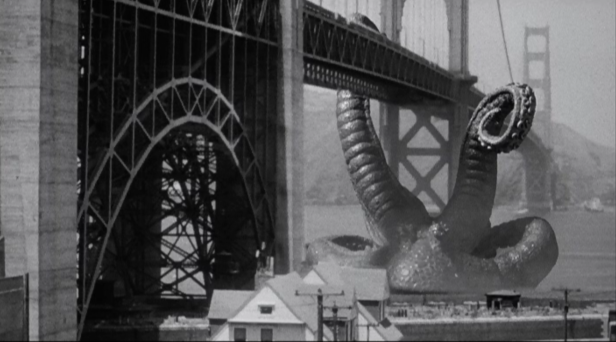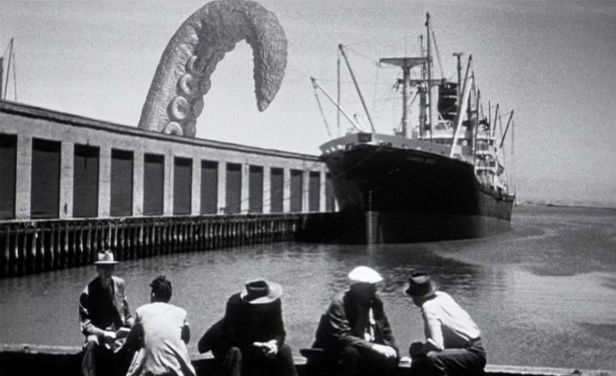A rather stodgy plot that simply recycles The Beast from 20,000 Fathoms (1953) and some of the least interesting characters seen in any 50s science fiction film tends to scupper Robert Gordon’s It Came from Beneath the Sea, despite another cracking Ray Harryhausen monster, a giant octopus (famously deprived of two tentacles by budgetary restrictions) which surfaces from the depths and attacks San Francisco. Gordon’s direction is plodding and the script by Hal Smith and George Worthing Yates pads out the non-monster scenes with the usual love story sub-plot that no-one really cares about and an awful lot of footage of stolid US Navy types going about their business. When the monster turns up it makes for far more stirring entertainment but is it enough to save the films?
It Came from Beneath the Sea not only reworks The Beast from 20,000 Fathoms, it owes something too to Ishiro Honda’s Gojira/Godzilla, released only two years earlier: the obligatory early scene of scientists discussing the problem even references the same incident involving a Japanese fishing boat contaminated by nuclear tests that partly inspired the Japanese film. Shortly afterwards, as if to hammer the point home, in the first major effects set-piece, Harryhausen has his tentacled terror attack and destroy a fishing boat, just as the King of the Monsters had done a couple of years before.

Deep in the Pacific Ocean, a submarine, captained by Commander Pete Matthews, encounters something large and aggressive and, returning to Pearl Harbour, the crew find part of a large animal caught in the boat’s dive planes. Marine biologists Lesley Joyce (Faith Domergue) and John Carter (Donald Curtis) identify it as part of an apparently gigantic octopus, irradiated by the American hydrogen bomb testing that drove it from its natural habitat in the Mindanao Trench. The creature is soon trashing fishing boats, snatching innocent bystanders from beaches in Oregon and and heading for a climactic rampage around San Francisco Bay.
Bad science, tedious romance and far too much stock footage of the US Navy on manoeuvres makes the first half of the film a bit of a chore but when the monster finally puts in its (almost) full appearance it all perks up admirably. For many, it’s too little too late and it’s easy enough to empathise with those who struggle with the film – the monster is a lot of fun, its attack on the Golden Gate Bridge being one of Harryhausen’s finest moments, but there is an awful lot of padding to get through first.

This isn’t unique to It Came from Beneath the Sea – many of the 50s Harryhausen effects extravaganzas tend to wilt whenever the monster disappears off screen leaving us with what are invariably under-developed and highly forgettable characters. It’s significant though as it’s the first pairing of Harryhausen with Charles H. Schneer, the producer that would oversee the very best films in the animator’s much-loved canon.
If you can get through the extremely tiresome human stuff – and admittedly it takes a special kind of fortitude to sit through all this nonsense twice – the climax is fabulous stuff but one can’t help but feel that it plays better in the clips in those “50-best-monster-movie” type shows. One can’t help but suspect that Smith and Worthing Yates came up with the idea of a giant octopus attacking San Francisco but couldn’t think of anything to actually do with it and came to the extraordinary conclusion that what we wanted was a half-arsed romance and some gung-ho Naval recruiting guff. How wrong could they have been?